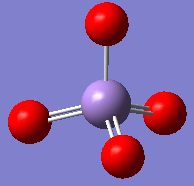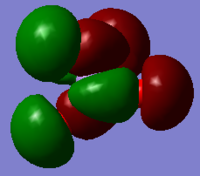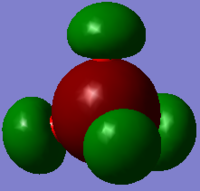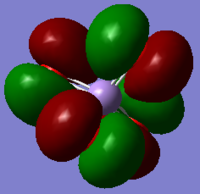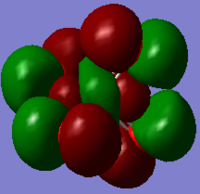Chl2118 comp
NH3 molecule
The full optimisation file can be found here.
Interactive molecule (Jmol file)
Interactive NH3 structure |
Summary information
| Calculation method | RB3LYP |
| Basis set | 6-31G(d,p) |
| Final energy (au) | -56.5577687299 |
| RMS gradient (au) | 0.000045 |
| Point group | C3V |
Structural information
| N-H bond length (Å) | 1.02 ± 0.01 |
| H-N-H bond angle (°) | 106 ± 1 |
In literature the bond length of N-H in NH3 is 1.019 ± 0.001Å and the bond angle is 109.1 ± 0.1° [1]. This value was found from an isolated molecule ie not part of a complex, which was also the case for the Gaussian calculation, suggesting that, despite Gaussian being theoretical, it is relatively accurate -- although it has a higher uncertainty.
Conversion of molecule forces
| Item | Value | Threshold | Converged? |
|---|---|---|---|
| Maximum force | 0.000004 | 0.000450 | YES |
| RMS force | 0.000004 | 0.000300 | YES |
| Maximum displacement | 0.000072 | 0.001800 | YES |
| RMS displacement | 0.000035 | 0.001200 | YES |
Vibrations and intensities
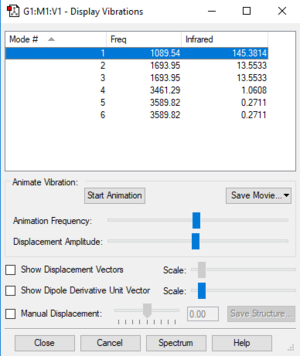
| Wavenumber cm^-1 | 1090 | 1694 | 1694 | 3461 | 3590 | 3590 |
| Symmetry | A1 | E | E | A1 | E | E |
| Intensity | 145 | 14 | 14 | 1 | 0 | 0 |
| Image |  |
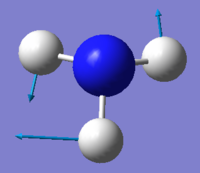 |
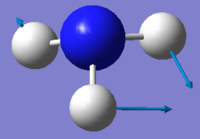 |
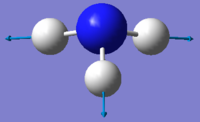 |
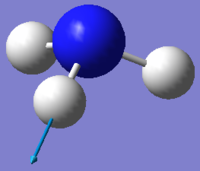 |
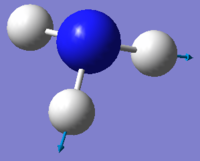
|
From the 3N-6 rule, 6 modes of vibration are expected. Two modes are degenerate (four different energies in total). There are three bending vibrations and three stretching vibrations. The fourth mode is highly symmetric -- both 1090cm-1 mode and the 3461cm-1 are symmetric, but with 3461cm-1, the point group doesn't change. The 1090cm-1 mode is known as the 'umbrella mode' (the bends are in the same direction at the same time). Two main bands would be seen in an IR spectrum of gaseous ammonia, as the intensity at 3590cm-1 is 0, and the peak at 3461cm-1 is so small it would be very difficult to see.
NBO charges
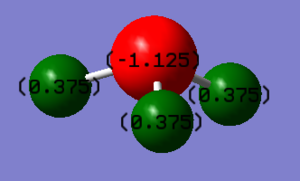
The charge on the central nitrogen atom is -1.125, and the charge on the H-atoms is +0.375. A negative charge would be expected for nitrogen as it is more electronegative than hydrogen and therefore would have a higher electron density (negative ion); a positive charge would be expected for the hydrogen atoms for the same reasoning.
N2
The optimisation file can be found here.
Interactive molecule (Jmol file)
Interactive N2 structure |
Summary information
| Calculation method | RB3LYP |
| Basis set | 6-31G(d,p) |
| Final energy (au) | -109.52412878 |
| RMS gradient (au) | 0.00000060 |
| Point group | D*H |
Structural information
| N-N bond length (Å) | 1.11 ± 0.01 |
| N-N bond angle (°) | 180 |
Conversion of molecule forces
| Item | Value | Threshold | Converged? |
|---|---|---|---|
| Maximum force | 0.000001 | 0.000450 | YES |
| RMS force | 0.000001 | 0.000300 | YES |
| Maximum displacement | 0.000000 | 0.001800 | YES |
| RMS displacement | 0.000000 | 0.001200 | YES |
Vibrations and intensities
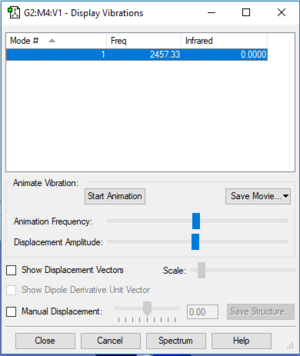
| Wavenumber cm^-1 | 2457 |
| Symmetry | SGG |
| Intensity | 0.0000 |
| Image | 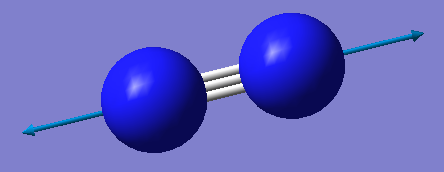
|
NBO charges

As N2 is a homonuclear diatomic molecule, the charge distribution on each atom is 0.
H2
The optimisation file can be found here.
Interactive molecule (Jmol file)
Interactive H2 structure |
Summary information
| Calculation method | RB3LYP |
| Basis set | 6-31G(d,p) |
| Final energy (au) | -1.17853935735 |
| RMS gradient (au) | 0.00000017 |
| Point group | D*H |
Structural information
| H-H bond length (Å) | 0.74 ± 0.01 |
| H-H bond angle (°) | 180 |
Conversion of molecule forces
| Item | Value | Threshold | Converged? |
|---|---|---|---|
| Maximum force | 0.168347 | 0.000450 | YES |
| RMS force | 0.168347 | 0.000300 | YES |
| Maximum displacement | 0.119698 | 0.001800 | YES |
| RMS displacement | 0.169278 | 0.001200 | YES |
Vibrations and intensities
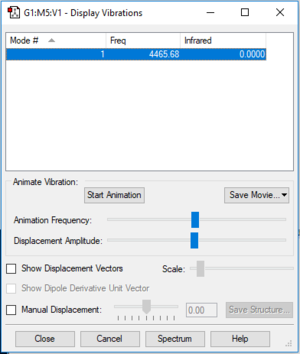
| Wavenumber cm^-1 | 4466 |
| Symmetry | SGG |
| Intensity | 0.0000 |
| Image | 
|
NBO charges
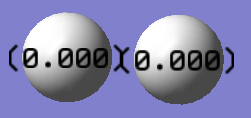
As H2 is a homonuclear diatomic molecule, the charge distribution on each atom is 0.
Mono-metallic transition metal complex with N2 coordinate
The link to the page can be found here.
| Structure | ||
|---|---|---|
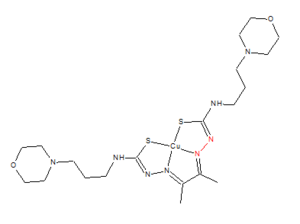
| ||
| 3D crystalline structure | ||
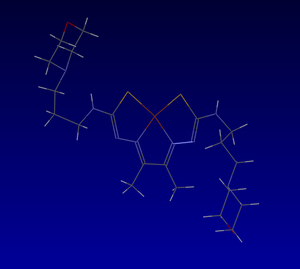
| ||
| More Info | ||
| Unique identifier | CANKEK | |
| N-N bond length (Å) | 1.37 ± 0.01 | |
In N2, the Gaussian bond length is 1.11 ± 0.01Å, but in the above compound it is 1.37 ± 0.01Å[2]. This increase in bond length could be due to the decrease in bond order - from three (triple bond) to one (single bond). Also, the nitrogen connected to the copper atom has a charge of +1 whereas the other nitrogen in the N-N bond has a neutral charge. As a result, the N-N may be weaker. Another possible reason is a difference between theoretical bond distances (Gaussian) and values found from experimental results -- this would suggest that the Gaussian bond length is less accurate than the experimentally found value.
The Haber-Bosch process
N2 + 3H2 → 2NH3
E(NH3) = -56.5577687299 au
2 * E(NH3) = -113.1155374598 au
E(N2) = -109.524128676 au
E(H2) = -1.17853935735 au
3 * E(H2) = -3.53561807205 au
ΔE = 2 * E(NH3) - [E(N2) + 3 * E(H2)]
ΔE = -0.05573652015 au
0.000038 au = 0.1 kJ/mol
-0.05573652015 au = -146.7 kJ/mol
ΔE = -146.7 kJ/mol
As the energy difference is a negative value, the reaction is exothermic and the product (ammonia) is more stable.
Project molecule - [MnO4]–
The full optimisation file can be found here.
Interactive molecule (Jmol file)
Interactive MNO4- structure |
Summary Information
| Calculation method | RB3LYP |
| Basis set | 6-31G(d,p) |
| Final energy (au) | -1451.84084417 |
| RMS gradient (au) | 0.00002308 |
| Point group | TD |
Structural information
| Mn-O bond length (Å) | 1.59 ± 0.01 |
| O-Mn-O bond angle (°) | 109 ± 1 |
The Gaussian Mn-O bond length is 1.59 ± 0.01Å, but this is 0.02Å different from the literature value[3], which gave a value of 1.61 ± 0.01Å as the Mn-O bond length. This difference in values could be due to the fact that the bond length from the literature value is from an Mn-O bond in a complex, which would affect the bond distance. Another explanation for the difference could be due to the Gaussian value being theoretical, whereas the literature value was found from an experimental process. As a result, the literature value is likely more accurate than the Gaussian bond length.
Conversion of molecule forces
| Item | Value | Threshold | Converged? |
|---|---|---|---|
| Maximum force | 0.000045 | 0.000450 | YES |
| RMS force | 0.000024 | 0.000300 | YES |
| Maximum displacement | 0.000081 | 0.001800 | YES |
| RMS displacement | 0.000043 | 0.001200 | YES |
Vibrations and intensities

In the following table, in some images the Mn-O bonds have been removed to show more fully the displacement vectors for vibrations.
| Wavenumber cm^-1 | 378 | 378 | 426 | 426 | 426 | 957 | 1018 | 1018 | 1018 |
| Symmetry | E | E | T2 | T2 | T2 | A1 | T2 | T2 | T2 |
| Intensity | 0.00 | 0.00 | 6 | 6 | 6 | 0.00 | 213 | 213 | 213 |
| Image |  |
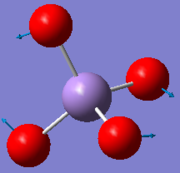 |
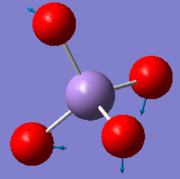 |
 |
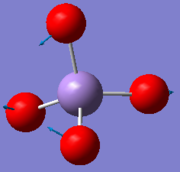 |
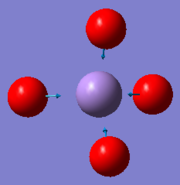 |
 |
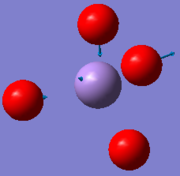 |
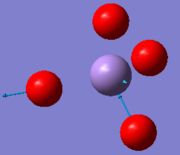
|
NBO charges
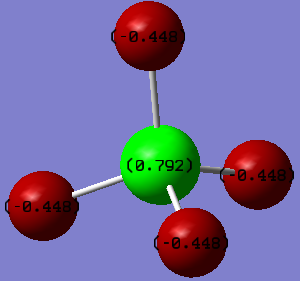
Molecular orbitals
References
Marking
Note: All grades and comments are provisional and subject to change until your grades are officially returned via blackboard. Please do not contact anyone about anything to do with the marking of this lab until you have received your grade from blackboard.
Wiki structure and presentation 1/1
Is your wiki page clear and easy to follow, with consistent formatting?
YES
Do you effectively use tables, figures and subheadings to communicate your work?
YES
NH3 1/1
Have you completed the calculation and given a link to the file?
YES
Have you included summary and item tables in your wiki?
YES
Have you included a 3d jmol file or an image of the finished structure?
YES
Have you included the bond lengths and angles asked for?
YES
Have you included the “display vibrations” table?
YES
Have you added a table to your wiki listing the wavenumber and intensity of each vibration?
YES
Did you do the optional extra of adding images of the vibrations?
YES
Have you included answers to the questions about vibrations and charges in the lab script?
YES
N2 and H2 0/0.5
Have you completed the calculations and included all relevant information? (summary, item table, structural information, jmol image, vibrations and charges)
YES, however you have given a bond angle of 180 for N2 and H2, there are no bond angles in diatomic molecules. Bond angles involve exactly 3 atoms.
Crystal structure comparison 0.5/0.5
Have you included a link to a structure from the CCDC that includes a coordinated N2 or H2 molecule?
YES
Have you compared your optimised bond distance to the crystal structure bond distance?
YES
Haber-Bosch reaction energy calculation 1/1
Have you correctly calculated the energies asked for? ΔE=2*E(NH3)-[E(N2)+3*E(H2)]
YES
Have you reported your answers to the correct number of decimal places?
YES
Do your energies have the correct +/- sign?
YES
Have you answered the question, Identify which is more stable the gaseous reactants or the ammonia product?
YES
Your choice of small molecule 4.5/5
Have you completed the calculation and included all relevant information?
YES
Have you added information about MOs and charges on atoms?
YES - good explanations overall well done! You could have attempted to explain the charge values you presented.
Independence 1/1
If you have finished everything else and have spare time in the lab you could:
Check one of your results against the literature, or
YES - Well done
Do an extra calculation on another small molecule, or
Do some deeper analysis on your results so far

